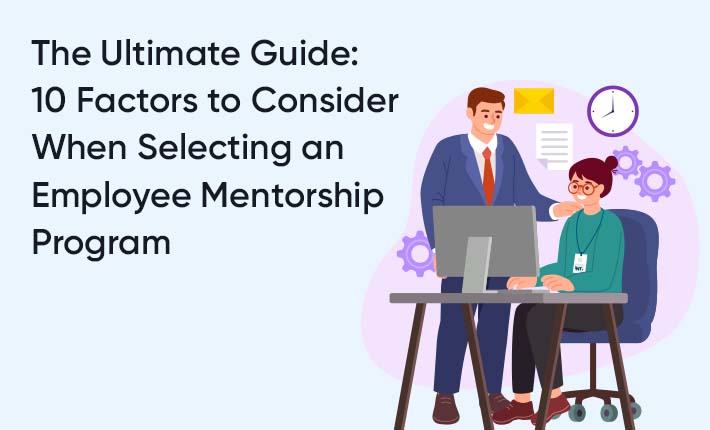In today's competitive job market, employee mentorship programs have become an essential component of companies' talent development strategies. These programs offer invaluable guidance, support, and professional growth opportunities for both mentees and mentors. However, with the multitude of options available, selecting the right employee mentorship program can be a daunting task. That's why we have created the ultimate guide to help you navigate through the process. In this comprehensive guide, we will explore the ten key factors that you need to consider when selecting an employee mentorship program. From defining your goals and objectives, to assessing program structure and compatibility, this guide will provide you with the insights and tools you need to make an informed decision. So, whether you are an HR professional looking to implement a mentorship program or an employee seeking mentorship, this guide is your go-to resource for finding the perfect match. Let's dive in and discover how you can unlock the full potential of mentorship in your organization or career.
Importance of employee mentorship programs
Employee mentorship programs play a crucial role in nurturing talent and fostering growth within organizations. These programs provide a structured framework for experienced employees to share their knowledge, skills, and experiences with mentees who are eager to learn and develop their careers. The benefits of implementing an employee mentorship program are numerous. Firstly, it helps to accelerate the learning curve for new hires and entry-level employees, enabling them to gain valuable insights and skills from seasoned professionals. Secondly, it creates a culture of continuous learning and development within the organization, which is vital for attracting and retaining top talent. Finally, mentorship programs have a positive impact on employee engagement and satisfaction, as they provide opportunities for personal and professional growth.
Employee mentorship programs have also been proven to enhance productivity and performance. Mentees have access to a wealth of knowledge and expertise, allowing them to develop new skills and gain a fresh perspective on their work. Mentors, on the other hand, benefit from the opportunity to enhance their leadership and coaching abilities, as well as gain a sense of fulfillment from helping others succeed. By investing in employee mentorship programs, organizations can cultivate a pipeline of skilled and motivated employees who are equipped to take on future leadership roles.
Factors to consider when selecting an employee mentorship program
1. Aligning the mentorship program with organizational goals
One of the critical factors to consider when selecting an employee mentorship program is to ensure alignment with the organization's goals and objectives. The mentorship program should complement the company's overall talent development strategy and contribute to the achievement of key business outcomes. For example, if the organization's goal is to enhance diversity and inclusion, the mentorship program should be designed to support this objective by providing mentorship opportunities to underrepresented groups. By aligning the program with organizational goals, you can maximize its impact and ensure that it is seen as a valuable investment by key stakeholders.
2. Defining objectives and goals for the mentorship program
Before selecting a mentorship program, it is crucial to define clear objectives and goals. What are you hoping to achieve through the mentorship program? Are you looking to develop specific skills, promote leadership development, or foster a culture of knowledge-sharing? By clearly defining your goals, you can evaluate mentorship programs based on their ability to meet these objectives. Additionally, setting clear goals will enable you to measure the success of the program and make adjustments as needed.
3. Identifying the target audience and their needs
Different mentorship programs cater to various target audiences, such as new hires, high-potential employees, or specific departments within the organization. It is essential to identify the target audience for the mentorship program and understand their unique needs and challenges. For example, new hires may require a structured onboarding mentorship program to help them navigate the organization and accelerate their learning curve. High-potential employees, on the other hand, may benefit from a mentorship program that focuses on their leadership development and career progression. By understanding the target audience and their needs, you can select a mentorship program that is tailored to their specific requirements.
4. Structuring the mentorship program - one-on-one or group mentoring?
When selecting an employee mentorship program, you need to decide whether a one-on-one or group mentoring structure is more suitable for your organization. One-on-one mentoring provides a personalized and focused learning experience, allowing mentees to receive individualized attention and guidance from their mentors. This structure works well for employees who require specific skill development or prefer a more intimate and confidential mentorship relationship. Group mentoring, on the other hand, brings together a small group of mentees with one or more mentors, fostering peer learning and collaboration. This structure is beneficial for employees who can learn from a diverse group of mentors and peers, and who thrive in a more social learning environment. The choice between one-on-one and group mentoring depends on the organization's culture, resources, and the objectives of the mentorship program.
5. Mentoring program logistics - duration, frequency, and format
When selecting an employee mentorship program, it is important to consider the logistics of the program, such as the duration, frequency, and format of the mentoring sessions. The duration of the program can vary depending on the goals and needs of the mentees and mentors. Some programs may run for a few months, while others may span over a year or longer. The frequency of the mentoring sessions should be determined based on the availability of mentors and mentees, as well as their preferred learning pace. As for the format of the mentoring sessions, it can be in-person, virtual, or a combination of both, depending on the organization's resources and technological capabilities. By considering these logistics, you can ensure that the mentorship program is feasible and convenient for both mentors and mentees.
6. Evaluating and measuring the success of the mentorship program
After implementing an employee mentorship program, it is crucial to evaluate its effectiveness and measure its impact. This can be done through various methods, such as collecting feedback from mentees and mentors, conducting surveys or interviews, and tracking key performance indicators. By regularly evaluating the mentorship program, you can identify areas for improvement and make necessary adjustments to maximize its effectiveness. Additionally, measuring the success of the program will allow you to demonstrate its value to key stakeholders and secure continued support and resources.
7. Implementing and managing the employee mentorship program effectively
Implementing and managing an employee mentorship program effectively requires careful planning and execution. It is essential to establish clear guidelines and expectations for both mentors and mentees, provide training and resources to support their roles, and facilitate regular communication and feedback. Additionally, creating a supportive and inclusive culture that values mentorship and recognizes the contributions of mentors and mentees is crucial for the success of the program. By investing in the necessary resources and support systems, you can ensure that the mentorship program is implemented and managed effectively, resulting in positive outcomes for all participants.
Conclusion
Selecting the right employee mentorship program is a critical decision that can have a significant impact on the professional development and growth of individuals and the success of organizations. By considering the ten factors outlined in this guide - aligning the program with organizational goals, defining objectives and goals, identifying the target audience, structuring the program, considering program logistics, evaluating success, and implementing and managing the program effectively - you can make an informed decision and choose a mentorship program that will unlock the full potential of mentorship in your organization or career. Remember, mentorship is a powerful tool for personal and professional growth, and by investing in the right program, you can create a culture of learning and development that benefits both individuals and the organization as a whole.






Leave a reply